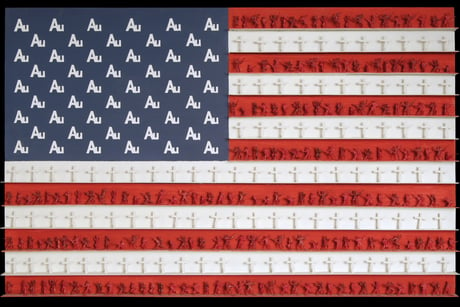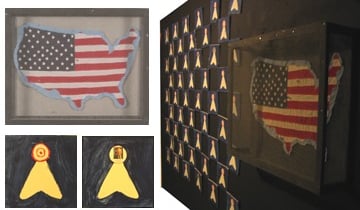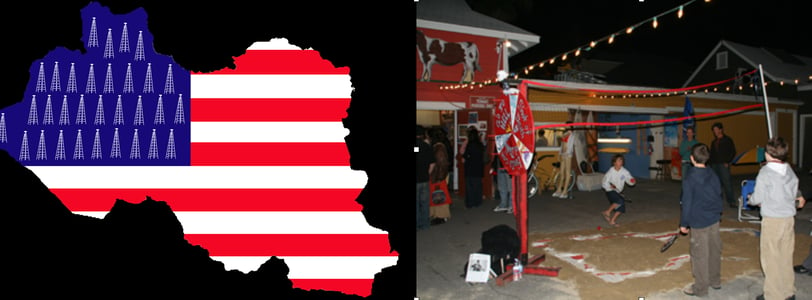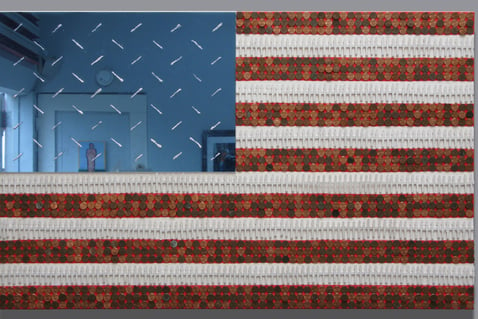Beyond Stars and Stripes: An American Artist's Perspective
a journey and commentary of my flag-based artwork
Dante Sigismondi
4/24/20256 min read
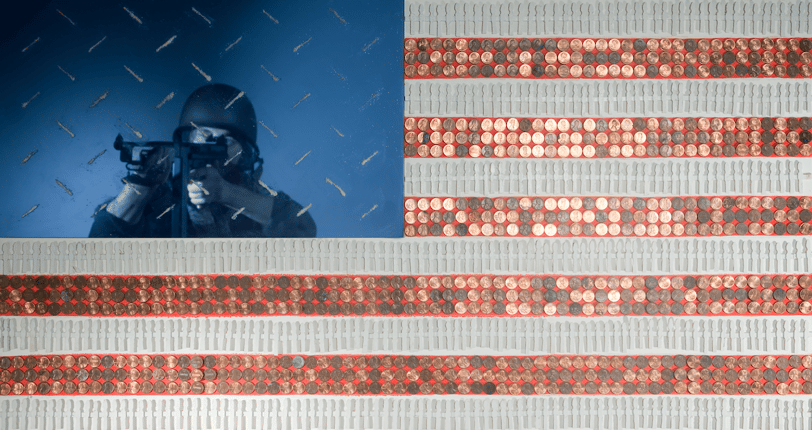

The flag under which I was born, its nationalistic and symbolic representation, has grown and evolved alongside my own development as a man and as an artist. For years, I haven't directly addressed this subject, perhaps feeling that the cleverness of those who mock and the hatred of nationalistic mobs would overshadow any impact my art could have on the viewer's sensibility, rendering my commentary futile.
However, the impulse for an artist to offer commentary and discuss the inconsistencies between the hopes and dreams of their homeland and the reality represented by the flag that flies above remains a natural one. So, I innocently followed the path of many artists, and until now, I have felt fortunate to have had the freedom to express and show my understanding of how this symbol has flown during my years in this land.
Bush Moths, 2004 was an interactive art installation featuring a U.S. flag in the shape of the United States, sewn from fabric and housed within a screen cage containing living moths. These moths cleverly symbolized and literally were eating away at the fabric of our nation's flag and the symbolic liberty it embodies. Adjacent to the caged flag, a grid of fifty hand-painted moths adorned the wall, each bearing a target at its head. In front of this hung grid, a sculpted moth rested on a table, serving as a pin cushion. Accompanying it were pins and photographs of the George W. Bush Administration, each image cut into a circular shape to correspond with the targets on the painted moths. The installation invited the spectator's interaction to directly identify the 'moths' eating away at our liberty. This deliberate act of pinpointing perceived culprits and the quotidian actions of the time, all within a chosen framework, creates a confined and potent commentary, setting the stage for my further explorations beyond the conventional understanding of the Stars and Stripes. Building upon this idea of deconstruction and symbolic replacement, Senza Confine, 2006 took a different form.
Senza Confine, 2006 is a large mixed-media U.S. flag constructed from wood, sheet metal, foam, toy soldiers, and wooden crosses. The traditional 50 stars representing the states were replaced with 'Au,' the elemental symbol for Gold. The white crosses, totaling 100, served as a placeholder for each member of the U.S. Senate, and the toy soldiers, while not the exact number of the U.S. Congress, represented at least half of the over 400 members in office. The title, 'Senza Confine,' is Italian for 'Without Limits,' a choice reflecting both my heritage and the continuity from my studies at the Belle Arti. On face value, the piece and its symbolic message can be read as: Without limits, we fly this flag in the pursuit of gold with military might and sacrificed lives. However, I have deliberately chosen the elemental symbol for gold ('Au'), red toy soldiers, and white crosses. These deliberate material and color choices within 'Senza Confine' – the scientific element 'Au' replacing familiar stars, the stark presence of white crosses, and the visceral red of the soldier figures – subtly introduce themes of unchecked progress, questioned religious narratives within a secular state, and the often-overlooked cost of conflict. This exploration of underlying tensions within national identity continued to evolve in my subsequent work, shifting focus to the interaction between nations in Acqua e Sabbia, 2007.
Acqua e Sabbia, 2007 was an installation piece representing the combined geographical area of Iran and Iraq. A large canvas, painted in the fashion of the U.S. flag with the blue section dotted with oil rigs and the rest with red and white stripes, was laid across the pavement and covered with sand. This layer of sand partially obscured the painted canvas, revealing only the outline of the conjoined countries with the underlying U.S. flag colors subtly visible. A volleyball net was positioned in the center of this sandy playing field. Throughout the installation, people played volleyball on the sand, and over time, their movements uncovered parts of the canvas, gradually blurring and ultimately disrupting the defined boundaries of the combined nations of Iran and Iraq. This act of playful disruption, while seemingly unifying in shared activity, still contains inherent dynamics of opposition and outcome, much like the complex and often obscured relationships between nations. This interplay between shared experience and underlying tensions, and the ways in which dominant forces – evidenced even in the subtle persistence of the U.S. flag's colors beneath the shifting sands – can permeate seemingly neutral spaces, even across arbitrary demarcations of territory, continued to inform my subsequent artistic explorations, leading to a consideration of cultural appropriation in American as Christmas, 2008.
American as Christmas, 2008 was a Christmas event featuring over 20 chipboard 3D Christmas tree cutouts, presented in both positive and negative forms, and all painted with the stars and stripes. The buildings around the square were illuminated solely with red, white, and blue Christmas lights. The central tree was constructed from copper tubing, reminiscent of the Charlie Brown Christmas tree, and uniquely supported gas-fueled flames at the end of each of its branches, as well as within the star at its apex. While spectators enjoyed the spirit of Christmas and each other's company with mulled wine, the event also served as an artistic commentary on the potential for America to present itself as if Christmas were primarily an American holiday, perhaps overshadowing the religious significance of Christ's birth due to the nation's perceived importance in creating the holiday. This reimagining of a traditional religious holiday as a distinctly 'American' event, much like the playful yet pointed interventions in earlier pieces, presents a seemingly simple and literal scenario – the warmth of the gas-lit 'Christmas' tree fostering a sense of gathering and sharing, the very tradition embodied by enjoying vin brûlé – that subtly provokes reflection on the complex intersection of national identity, cultural appropriation, and the potential secularization of sacred traditions. This thread of questioning underlying values continued in the stark self-reflection demanded by The Lines We Cross, 2009.
The Lines We Cross, 2009 is a large mixed-media U.S. flag constructed from wood, U.S. pennies, blue mirror, white powder, and wooden sticks. Hundreds of red copper pennies fill the red stripes, while white picket fence segments overlay the white stripes. The blue field is a mirror upon which 50 lines of white powder, resembling cocaine, are arranged in place of the stars. Observing this piece, the spectator sees their own reflection through these lines, prompting reflection on the title, 'The Lines We Cross.' They can also consider the symbology of what actions one might take – perhaps even crossing questionable lines – to achieve the American dream of the white picket fence or what one might have to do to earn a 'red cent.' In 'The Lines We Cross,' the mirrored surface compels a direct and unavoidable self-reflection, forcing the viewer to confront their own potential complicity within the complex and sometimes compromised pursuit of American ideals symbolized by the juxtaposed imagery. This intimate and challenging encounter serves as a potent culmination to the series' exploration of national identity and its underlying realities.
Fifteen or more years have passed since I created those flag-based artworks, and I'm not entirely sure why I haven't returned to that subject. Perhaps during the Obama years, a false feeling of hope was enough to temporarily stabilize the symbology and nationalistic resonance of our flag's image. When Trump's first presidency came, it only reinforced the ideas and sentiments already present in the flags I had made, negating the need to make them again – a strange echo of his own insistence that the past could be resurrected, much like I ran out of my 24-karat gold spray paint – the kind that transformed plaster cherubs into the illusion of solid gold – and chose not to buy more. During the Biden years and post-Covid, the thought of a 'cozy blanket flag' even flickered in my mind, but AI and China can deliver on demand, reaffirming humanity's and America's feeling of hopelessness. In reality, it feels as though the profound symbology the flag once held has vanished entirely. People seem to consume only manipulated and manufactured fragments of a contrived past, endlessly repeated, gripped by a fear of originality. You might even say the authentic artist's voice has been lost, stifled within the promotional 'death loops' of galleries and museums that dictate trends rather than seeking and valuing unique perspectives. In fact, a broader silencing has occurred, with fresh voices and perspectives across all institutions fading, leaving a void that cannot be filled by one man's agenda, an authoritarian will with our flag and our symbolic liberty seemingly unattainable, flying high on a 100-foot pole.
